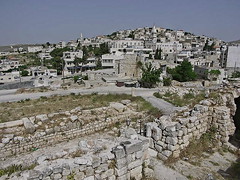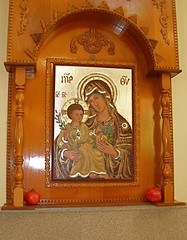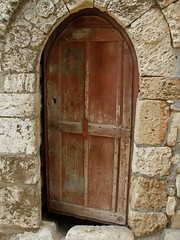Among Postcards from a friend, there followed discussion on the illustration of the special Chapel of the Blessed Sacrament in the Liverpool Cathedral.
The print of the Postcard obscured the painting or structure above the Tabernacle. The lower section is a mural painting, abstract colours. The upper section suggested line drawing of a canopy on the wall.
Closer examination of pictures from the Website makes it is perfectly clear..
The Visitors’ Tour gives better commentary.
See before.
On the main axis, the BLESSED SACRAMENT CHAPEL, the largest of the peripheral chapels, contains the tabernacle by Ceri Richards in which the Sacrament
is reserved. Richly ornamented in gilt metal, glass and enamels, the centre door symbolises the glory of God, depicted by the heavens and constellations, with the side doors showing the chalice and host. The great triangular windows and the reredos, also by Richards, are together with the tabernacle part of a triptych of colours.
The bronze figure of the Risen Christ is by Liverpool born Arthur Dooley
Blessed Sacrament Chapel at the Metropolitan Cathedral of Christ the King, Liverpool
From the Website
On the main axis, the BLESSED SACRAMENT CHAPEL, the largest of the peripheral chapels, contains the tabernacle by Ceri Richards in which the Sacrament
is reserved. Richly ornamented in gilt metal, glass and enamels, the centre door symbolises the glory of God, depicted by the heavens and constellations, with the side doors showing the chalice and host. The great triangular windows and the reredos, also by Richards, are together with the tabernacle part of a triptych of colours.
The bronze figure of the Risen Christ is by Liverpool born Arthur Dooley.
is reserved. Richly ornamented in gilt metal, glass and enamels, the centre door symbolises the glory of God, depicted by the heavens and constellations, with the side doors showing the chalice and host. The great triangular windows and the reredos, also by Richards, are together with the tabernacle part of a triptych of colours.
The bronze figure of the Risen Christ is by Liverpool born Arthur Dooley.
The Historic Churches Commission has refused to authorise the reordering of the Blessed Sacrament Chapel at the Metropolitan Cathedral of Christ the King, Liverpool. The change would have involved siting a new, smaller altar at a lower level.It is difficult to say whether Frederick Gibberd had an underlying geometrical plan for the Blessed Sacrament Chapel that might explain the proportions and position of individual elements. Unity is provided by the combination of colour, line, light and relief in Ceri Richards’ great painted reredos, tabernacle doors and stained-glass windows. The original intention was that Richards would produce an altar frontal as part of the scheme. This was never executed.














